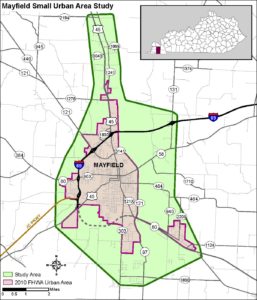 MAYFIELD, KY (August 5, 2020) – The Kentucky Transportation Cabinet (KYTC) is continuing to offer Mayfield area residents an opportunity to comment on a city-wide planning study of transportation issues. Online comments on the Mayfield Small Urban Planning Study will be accepted through Friday, August 14, 2020.
MAYFIELD, KY (August 5, 2020) – The Kentucky Transportation Cabinet (KYTC) is continuing to offer Mayfield area residents an opportunity to comment on a city-wide planning study of transportation issues. Online comments on the Mayfield Small Urban Planning Study will be accepted through Friday, August 14, 2020.
The study is examining a number of transportation safety and congestion issues within the Mayfield area. About 3/4ths of the way through the online public participation process, more than 150 comments have been made on an interactive website.
According to KYTC District 1 Chief Engineer Kyle Poat, the study is to identify long-term projects for future planning and also short-term traffic safety enhancements that can be implemented quickly and effectively.
Analysts are investigating existing traffic patterns and studying recent crash data to understand big-picture issues in and around Mayfield. Public input will help focus the study on specific needs. Both Mayfield residents and motorists who regularly drive through Mayfield are encouraged to participate.
The study seeks answers to a number of transportation questions:
• Are there bottlenecks or congested intersections with long waits?
• Are there turns where drivers have limited vision?
• Are there curves or narrow lanes or shoulders?
• Are there intersections that could benefit from a turn lane?
Citizens can participate in the study by going to https://bit.ly/2VfER8k. The GIS-based platform allows you to drop a pin and describe specific conditions at locations that may be worthy of additional study by the project team. The site will be live to gather public comments through Aug. 14.
Once community input is collected, KYTC engineers and consultants will conduct a technical analysis of each location to develop proposals for safety and traffic flow enhancements at specific sites.
A study report will be published in 2021 to identify improvement priorities and planning-level cost estimates. The information can then be used to aid decision-makers in seeking funding for proposed projects and to guide inexpensive traffic flow configuration adjustments that can enhance safety.
